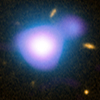CXC Home | Search | Help | Image Use Policy | Latest Images | Privacy | Accessibility | Glossary | Q&A
Tour of GB 1428+4217
Quicktime MPEG
The most distant jet in X-ray light has been discovered using data from NASA's Chandra X-ray Observatory. This jet was found in the quasar known as GB 1428+4217, or GB 1428 for short. How does GB 1428 make its jet? When giant black holes pull in material at a very rapid rate, large amounts of energy are released. This results in the production of intense radiation and beams of high-energy particles that blast away from the black hole at nearly the speed of light. Astronomers call these beams of particles "jets". At a distance of 12.4 billion years from Earth, the jet in GB 1428 gives astronomers a glimpse into the explosive activity associated with the growth of giant black holes in the early Universe.
[Runtime: 01:01]
Quicktime MPEG
The most distant jet in X-ray light has been discovered using data from NASA's Chandra X-ray Observatory. This jet was found in the quasar known as GB 1428+4217, or GB 1428 for short. How does GB 1428 make its jet? When giant black holes pull in material at a very rapid rate, large amounts of energy are released. This results in the production of intense radiation and beams of high-energy particles that blast away from the black hole at nearly the speed of light. Astronomers call these beams of particles "jets". At a distance of 12.4 billion years from Earth, the jet in GB 1428 gives astronomers a glimpse into the explosive activity associated with the growth of giant black holes in the early Universe.
[Runtime: 01:01]
(Credit: NASA/CXC/A. Hobart)
Return to GB 1428+4217 (November 28, 2012)



